Article
The Greek Island of Kos and, Again, the Delight in Remembering Hippocrates
Author(s):
The magnificent Greek island of Kos marries natural beauty with a unique history that will be of particular interest to physicians. However, travel to the island has been tricky of late, due to the European migration crisis.

I am sitting on the balcony of our downtown condo in San Diego enjoying what romantics might call the autumn of their years. The late afternoon sun slides slowly across our horizon. In a moment its light will hit one of my favorite travel souvenirs and illuminate a china plate I bought in 1984 at the Clarisse ceramic factory in Greece on the island of Kos. I need to remind my family I want to leave it to my personal physician one day. Despite the chip at 9 o’clock on its face, it is a treasured memento of a traveling life. Nevertheless, I see Clarisse keramik plates are available on eBay for about five dollars!
Thirty one years ago, my late wife Margaret and I were in Greece doing some courtesy work for John Pittas at the Greek National Tourist Office when we suddenly were free for several days. We asked John how we might get over to Kos, an island lying a mere three miles from the Turkish border. We had heard the ferry took almost a complete day to get there. He came to a decision as sudden as ours. “You need to fly.” He said, “And let me arrange it -- and your hotel there; it’s the least we can do for all the work you’ve done for us.”
Greece the way it used to be!
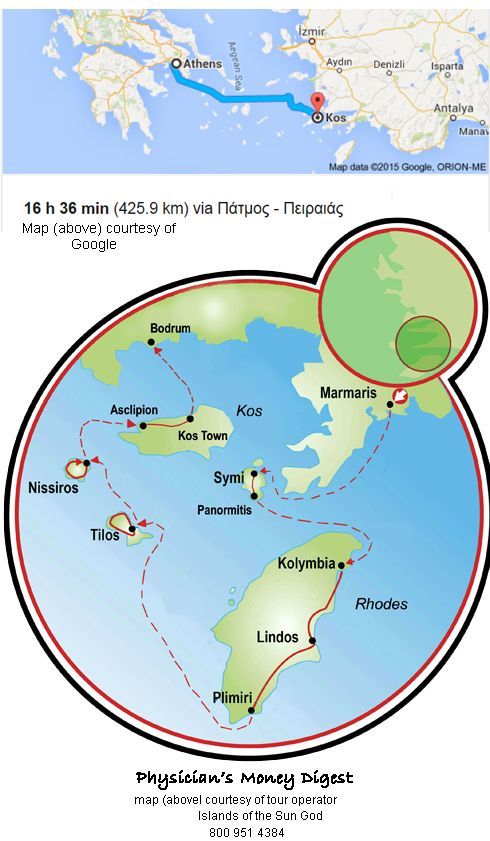
The island of Kos offers difficulties for tourists. It is so close to Turkey that, even as the Greek economy collapses, it has become a favored destination for illegal immigrants.
The next day we were sitting in an airplane at Athens airport. It filled up rapidly while I scribbled some notes (which I still have years later).
The passengers comprised an eclectic bunch: Bronzed blondes jabbering in German, British tourists sweating in their heavy tweeds, young Greek couples incessantly smoking and blowing their fumes carefree into each other’s eyes, island families returning after a day in the city, and exhausted babies crying in their mother’s arms. Elderly men awkwardly feeling their slow way down the aircraft corridor carrying -- like waiters bearing trays -- crumpled cardboard boxes bound in twine, or dragging plastic bags incongruously labeled “Camel Cigarettes” or “Dewar’s Whiskey,” stuffed with newspapers, rugs, boots and jackets. Thin stooped women -- in the mournful black they’ll wear for 40 years of widowhood. A Greek priest, as always bearded, pausing indulgently on his way to his seat to permit a woman to kiss his hand. Two Spaniards sweeping down the passage, inches apart yet shouting incoherently at each other. A tourist, again German, laden with the most expensive photographic equipment that was ever sold 40 years ago -- all gleaming, stainless steel and heavy on his neck.
Our airplane landed on an island much different from today’s Kos. Then Greece seemed delightfully naïve, innocent almost of the cultural changes roiling Europe and even America. Yet within a decade we were reading about what happened when the tourist industry promoted the concept of prepaid all-inclusive vacations to the British and German public. British young men in particular were thrilled to discover how lax the age limit was on Kos for alcohol purchase compared to their own country’s law. Tourists who made the mistake of coming at a time that coincided with college vacations discovered an experience even worse than taking a vacation during American Spring Break. The population of Kos is only 30,000.
Right now the situation is even worse because the tourist experience on Kos can no longer be ruined merely if you choose the wrong dates; it can be spoiled if you come when the EU has not just lost control of the economy but failed to deal with the undealable, its illegal immigration. In midsummer 2015 hundreds of Middle Eastern immigrants were somehow reaching Bodrum on the Turkish coast and paying 800 Euros each to Europe’s version of Mexico’s coyotes to be taken by boat to Kos. UK Daily Mail Reporter Sue Reid warned about this at the end of May 2015 saying, “This week 1,200 migrants washed up on a Greek island beloved by British tourists. Easily navigated Aegean Sea has become new back door to EU countries. 300 asylum seekers arriving on the popular holiday Greek island Kos a day.”
What does all this mean for our healthcare professional readers? More than it does for average American tourists because Kos, more difficult to reach, has always been below their radar. Individual travelers today should investigate the current situation very carefully and use a bonded travel agent or company and, as usual, pay by credit card. An even better choice might be to use a long-established tour operator like Viator for the entire trip and turn it into a brief Hippocratic experience where you make it clear what your needs are and ask can Viator meet them?
Further problems are that tour operators might already expect to find you have reached Kos from Athens by yourself as a day trip from Athens to Kos with some sightseeing and a same-day return to Athens is not possible. If I was returning to Kos today I would surely do it by finding a dependable travel agent and taking time to discuss it all well in advance. I might try the Matt Barrett’s Greece Travel Guide service because he seems very down to earth and a good choice but I’d want references, too. Explore his web pages; he really knows Greece. And you can ask him stuff by email!
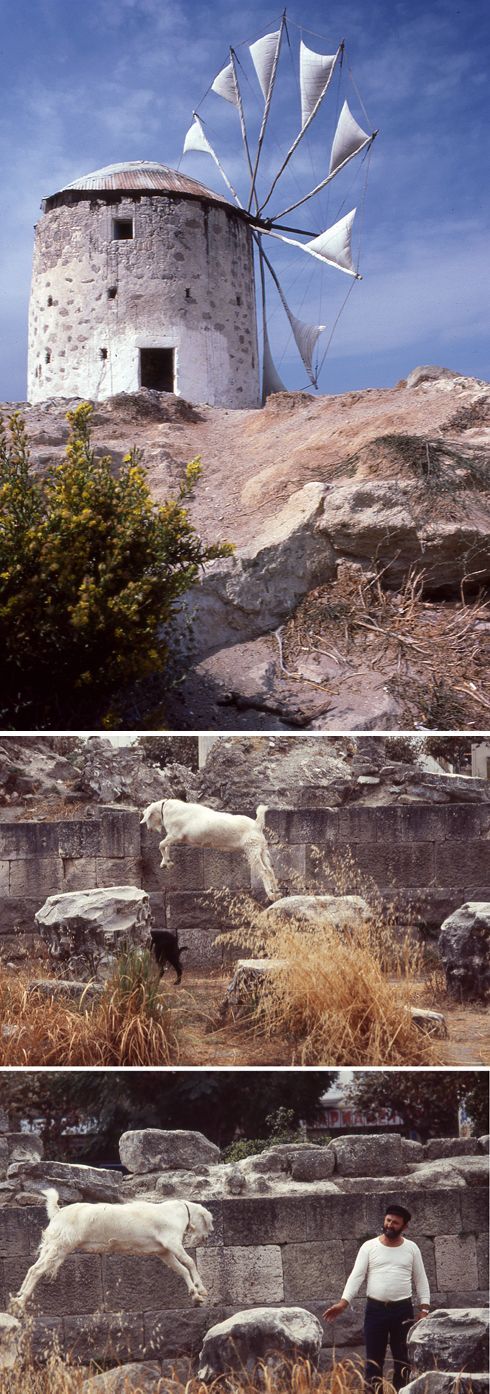
This is why I remember Greece as then innocent. We saw a goat jumping backwards and forwards from rock to rock in the agora near the town square. What a peculiar sight! Then the owner appeared to supervise. He was training it for a circus show
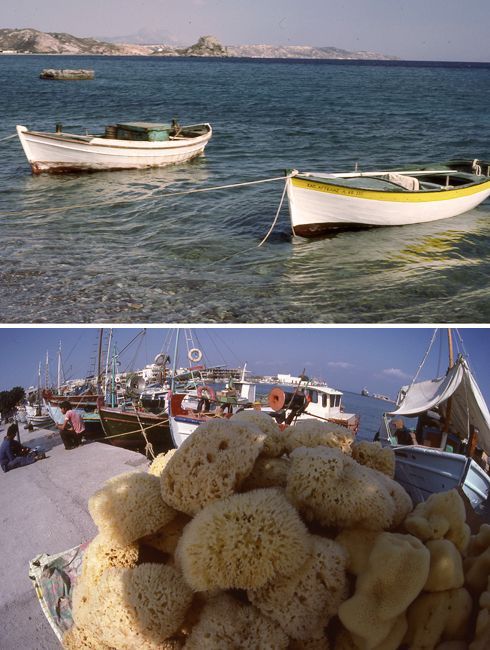
The harbor still will seem laid-back. Sponge fisherman will chat and sell you a sponge that will give you Kos memories too
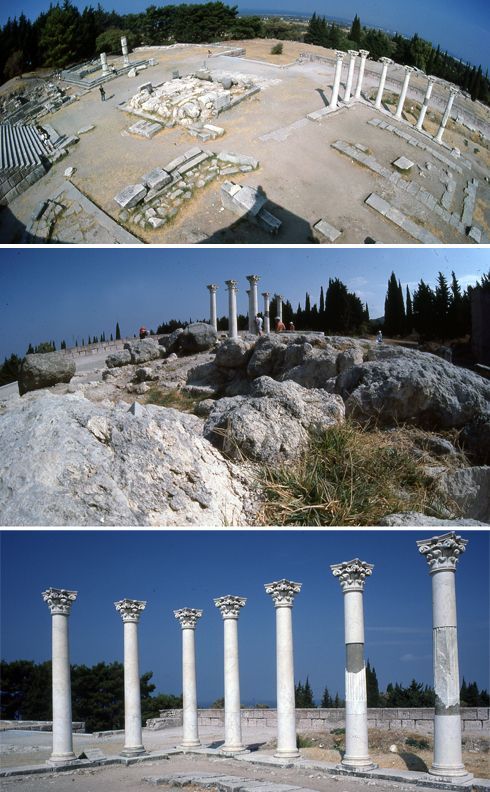
Mark Dubin at Matt Barrett’s Kos has useful information about the island and town of Kos. The best description I have found of the Asklepion in Kos is on the website of a once obscure Irish newspaper now revived by the internet, the Skibbereen Eagle
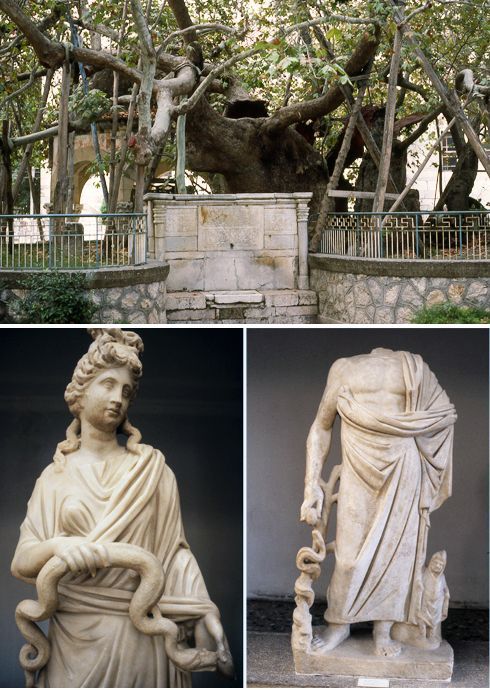
The tree “under which Hippocrates taught his students 2500 years ago” is certainly old, probably aged 700 years. Tourist offices do delight in massaging statistics. Maybe it was planted from the seed of a plane tree that had in turn been planted from the original tree but it is growing in the right location and what physician visitor has not eased up against the wall and looked up and possibly fantasized a little? Kos Archaeological Museum. Images bottom left: the statue of Hygieia, Yγιεία the daughter of the god of medicine Asclepius. Bottom right: maybe a statue of Hippocrates but even with the head that identity would be hard to prove as there are no validated images of his face
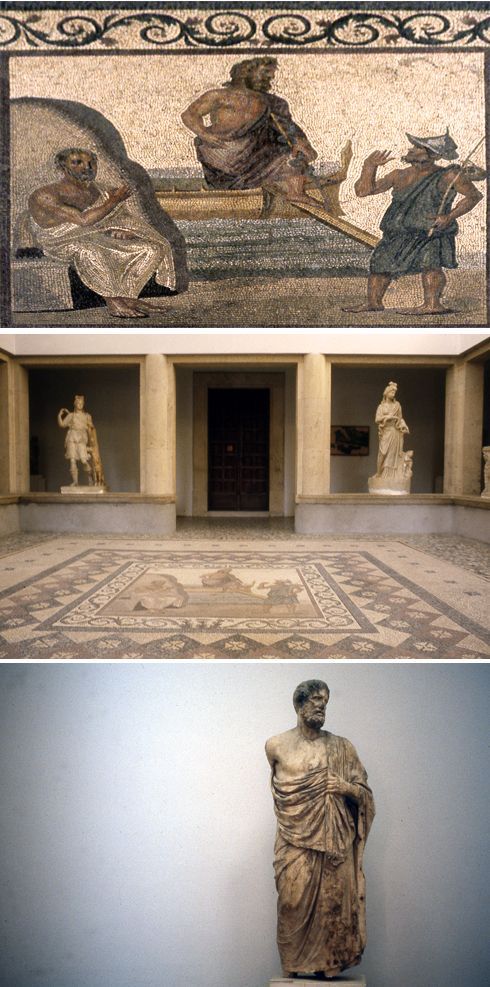
Mosaic floor from Roman villa, Casa Romana. Possible statue of Hippocrates
The Kos Archaeological Museum was less developed in the 1980s. It was also very empty of visitors. I was able to lean over one of its treasures, a mosaic floor from the Casa Romana, a Roman villa that was being renovated. The mosaic showed Asklepios, the god of healing, arriving on the shores of Kos and being welcomed by an islander and by Hippocrates himself. It was created in the third century AD, about 600 years after the death of Hippocrates.
However beyond the Roman courtyard stood a statue, at my visit guarded by a bearded and bent over old man who seemed terrified that I might raise the camera hanging around my neck and, gulp, try and photograph the statue he was guarding to prevent that very activity.
It was in the days before digital photography where museums across the world had not made their decisions whether to allow or outlaw visitor photography. Now, today, if museums do allow visitor photography it’s a disaster for everyone. Any image will be full of people holding up iPads and the magic will be gone.
The statue was said to be 4th century BC, the time of Hippocrates. It surfaced after an earthquake disturbed the Odeon in 1933. It was identified by Italian architects as Hippocrates.
For me it was an unnerving moment in this empty museum. The sun streaming in through the overhead window bathed the statue in a strange, spooky, green light as the figure stared into the distance. I dropped down on to the floor and stared back.
I look at my old notes. “The ‘sentry’ frowned and pointed to the sign ‘No Photography.’ I looked at him. He shook his head. I tried to show how entranced I was with his statue, his museum, his island, his country. He shook his head. I held my hand ‘he said, ‘Yes, OK.’ Wondering if this could indeed be Hippocrates and overwhelmed by the thought -- I lifted my camera. And, for maybe a corny, but for me, mystical moment, I felt somehow my own career was validated and my life work complete.”
Photography by the author
The Andersons, who live in San Diego, are the resident travel and cruise columnists for Physician's Money Digest. Nancy is a former nursing educator, Eric a retired MD. The one-time president of the New Hampshire Academy of Family Physicians, Eric is the only physician in the Society of American Travel Writers. He has also written five books, the last called The Man Who Cried Orange: Stories from a Doctor's Life.











